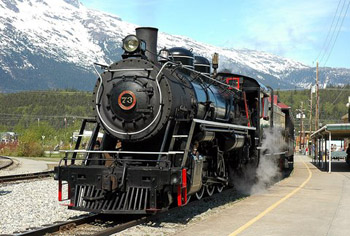
Gold Rush Narrow Gauge Train from Skagway, Alaska
by Glen Brewer
The White Pass & Yukon Route was built to take miners and supplies to the newly discovered Klondike gold fields. That was over a century ago, but now the gold rush of Alaska cruise ships is bringing far more business to this narrow gauge railroad than the original gold rush ever did.
I arrived in Skagway by ship, as did so many adventurers on their quests after riches. My ship, of course, was one of several large cruise ships that arrive every day during Alaska’s short tourist season, not one of the picturesque, small steamers of the Klondike days. Four ships were in port the day I arrived.
I was anxious to see what transportation challenges the early pioneers and the railway construction and operating men faced. As do most of today’s travelers, I boarded my train on the dock, right alongside my ship.
Gold was discovered in 1896 along the Klondike River of the Yukon Territory, but, due to the extreme remoteness, it took quite a while for news to reach civilization: it wasn’t until July of 1897 that the first successful prospectors arrived in Seattle telling their stories of great riches waiting to be scooped up.
 These were depression times, especially in the mining industry. The United States Government had committed to purchase silver at a fixed, 16 to 1 ratio compared to gold. Silver mining boomed, but eventually the US treasury gold supply was nearly depleted. In 1893 the law was repealed. Mines closed – most never to reopen. Suppliers failed, railroads failed, the steel industry was in serious trouble. Soon the US sank into the worst depression it had ever known.
These were depression times, especially in the mining industry. The United States Government had committed to purchase silver at a fixed, 16 to 1 ratio compared to gold. Silver mining boomed, but eventually the US treasury gold supply was nearly depleted. In 1893 the law was repealed. Mines closed – most never to reopen. Suppliers failed, railroads failed, the steel industry was in serious trouble. Soon the US sank into the worst depression it had ever known.
Silver had lost its luster, but not gold. Soon hordes of intrepid gold seekers were bound for the Klondike. Most of them took steamers from Seattle or Vancouver, and then packed their goods over one of two tortuous routes: the shorter but steeper Chilkoot Trail starting from Dyea or the longer but slightly easier White Pass Trail starting at Skagway. To make things worse, these hardy adventurers often traveled in winter. Of course, they were in a hurry to be among the first to reach the gold fields, but also it was easier to move supplies over snow and ice than mud and sharp rocks. Plenty of survival goods had to be packed by every traveler: Mounties required each person entering Canada to have at least one ton of supplies – the amount judged necessary for one person to survive for a year.
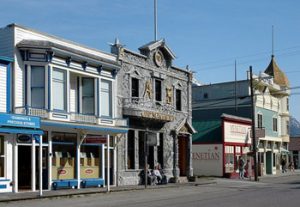 Construction of a three-foot gauge railroad from Skagway, Alaska began in 1898. By then the construction of a narrow gauge railway was unusual. Narrow gauge (any less than the “standard gauge” of four-feet eight and one-half inches between the rails) was a bit of a fad in the railway business. It was very popular for new construction starting about 1872 and then rapidly declined over the next twenty-five years. Basically the narrow gauge era was already a thing of the past when the White Pass selected it, but the advantages of cheaper and quicker construction for the narrower, lighter tracks which allowed tighter curves and less earth moving were just as compelling here as they had been in Wales and in Colorado a few years before.
Construction of a three-foot gauge railroad from Skagway, Alaska began in 1898. By then the construction of a narrow gauge railway was unusual. Narrow gauge (any less than the “standard gauge” of four-feet eight and one-half inches between the rails) was a bit of a fad in the railway business. It was very popular for new construction starting about 1872 and then rapidly declined over the next twenty-five years. Basically the narrow gauge era was already a thing of the past when the White Pass selected it, but the advantages of cheaper and quicker construction for the narrower, lighter tracks which allowed tighter curves and less earth moving were just as compelling here as they had been in Wales and in Colorado a few years before.
The last spike was driven and the railroad opened for business in 1900 extending for 110 miles to Whitehorse, Yukon Territory. But by that time, the gold rush was nearly over. Business settled to a slower pace of hauling mining concentrates and supplies.
Business really boomed for the first time during World War II as the US government built the new Alaska Highway – considered a high wartime priority. The railway was taken over and operated by the US Army; additional equipment was requisitioned from Colorado and elsewhere. As many as thirty trains operated per day delivering materials for the new road.
After the war, since there was still no highway between Skagway and Whitehorse, business continued. There was no interchange with any other railroad; therefore, the gauge was not a problem as it had been for other narrow gauge railroads. The White Pass became an innovator in container service, operated docks, ships and even airplanes. But by 1982 a highway was finally built. Business declined precipitously, and the railway shut down.
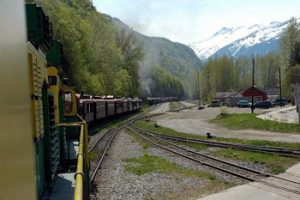 That looked like the end of the line for the narrow gauge, but fortunately, the Alaskan cruise business was quickly growing. Optimistically the White Pass reopened in 1988 and carried 35,000 passengers on its first year of renewed service for the cruise trade.
That looked like the end of the line for the narrow gauge, but fortunately, the Alaskan cruise business was quickly growing. Optimistically the White Pass reopened in 1988 and carried 35,000 passengers on its first year of renewed service for the cruise trade.
On an unusually fine, sunny, warm early afternoon, my train, right on schedule, took its place in a grand procession of four separate trains proceeded out of town, each within sight of the one ahead. Our ascent to White Pass began almost immediately and grew ever steeper: much of the way to the summit is on a 3.9% grade.
At Rocky Point, there is a sharp curve to the right and a fine view looking back over the tree tops back to Skagway, the Lynn Canal and Mt. Harding. All four cruise ships were easily seen at their docks.
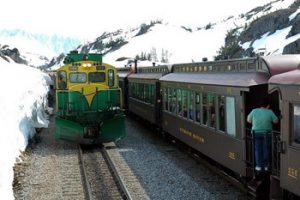 Remnants of the old Brackett Wagon Road appeared below the track level. By November of 1897 George Brackett began to do something about the hardships of the White Pass Trail. He built a wagon road part way up the pass. The toll was set high, and so many travelers ignored the tollgates, that the Brackett road was soon a failure. The road certainly must have been an improvement, but even considering deterioration over the years, it did not appear an easy road to traverse.
Remnants of the old Brackett Wagon Road appeared below the track level. By November of 1897 George Brackett began to do something about the hardships of the White Pass Trail. He built a wagon road part way up the pass. The toll was set high, and so many travelers ignored the tollgates, that the Brackett road was soon a failure. The road certainly must have been an improvement, but even considering deterioration over the years, it did not appear an easy road to traverse.
Along the way, we were treated to views of waterfalls cascading down the mountainsides. The most prominent of these is the Bridal Veil Falls across the canyon and intersected on its way down the mountain by Highway 2.
A porcupine scampered away from our approaching train. Passengers often see bears and mountain goats on the mountainside near the tracks. These animals seem quite used to the passage of the trains and are not usually much disturbed by them.
 As we headed into a hairpin curve, I could see the train ahead high above on the mountainside. It was on a narrow shelf blasted from the hard rock of the mountainside. Men dangling from ropes drilled and blasted these shelves for the track bed.
As we headed into a hairpin curve, I could see the train ahead high above on the mountainside. It was on a narrow shelf blasted from the hard rock of the mountainside. Men dangling from ropes drilled and blasted these shelves for the track bed.
Beyond the shelf, the tracks curve around the mountain and to what is probably the most photographed spot in the more than one-hundred years of this railway. Here the tracks first curve back to the left onto a spindly looking, high, wooden trestle and then immediately plunge into a dark curving tunnel. Soon there was snow on the ground around us, and as we climbed onward, it became deeper.
Our train passed the original cantilevered, steel, bridge across a deep chasm. The bridge, bypassed by a new tunnel in 1969, is still in place. It sure doesn’t look like it would ever have supported all those Army trains of World War II. A little more evidence of the old trail up this pass was evident below as we approached the pass itself and the British Columbia border. By then the snow was quite deep. A previous train waited for us at the White Pass siding.
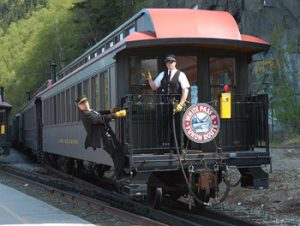 For most trains, White Pass is the turning point for the ride back to Skagway. Our brakeman cut off the engine so that it could run around the passenger cars and re-couple at the other end. Then we backed out of the siding and pulled forward past the following train, which by then had pulled into the siding for us to pass. We then had a clear track back to Skagway.
For most trains, White Pass is the turning point for the ride back to Skagway. Our brakeman cut off the engine so that it could run around the passenger cars and re-couple at the other end. Then we backed out of the siding and pulled forward past the following train, which by then had pulled into the siding for us to pass. We then had a clear track back to Skagway.
Since reopening for the tourist trade the White Pass & Yukon Route has become the busiest tourist railway in North America operating as many as 14 passenger trains a day. In 2007 a record of 461,388 passengers were carried, and despite the economic downturn, 2008 was still the second best ridership in 108 years with over 437,000 passengers carried.
For the White Pass line, the gold rush is finally here. The railroad itself is a triumph of nineteenth century perseverance and engineering – a fact recognized in 1994 when the line was designated as an International Historic Civil Engineering Landmark. For passengers like me it is a bonanza of fascinating history and always impressive mountain scenery.

Skagway Shore Excursion: White Pass Summit and Skagway City Tour
If You Go:
A round trip to White Pass takes about three hours. A few selected trains go on to Fraser, BC and even to Carcross, YT. On weekends only, a steam train runs to Fraser.
White Pass & Yukon Route
P. O. Box 435
Skagway, AK 99840
800-343-7373
Skagway itself is a fascinating little town with an interesting history. Downtown streets still look much as they did in late gold rush days. The estimated year around population in 2007 is only 798 people; when it was incorporated in 1900, the population was 3,117.
www.skagway.com
Many of the preserved, historical buildings of Skagway are operated by the US National Park Service as part of the Klondike Gold Rush National Historical Site.
US National Park Service
P. O. Box 517
Skagway, AK 99840
907-983-2921
Although the majority of passengers arrive in Skagway aboard cruise ships operating out of Vancouver or Seattle, Skagway may also be reached by commuter flights from Juneau, car ferries of the Alaska Marine Highway System, or even by highway.
About the author:
Glen Brewer is a freelance writer and photographer residing in Denver, Colorado. Previously published travel and features have appeared in The Chicago Tribune, Vancouver Province, Denver Post, and Arizona Star. His railway oriented articles have appeared in Classic Trains Magazine, Rail & Wire, O-Scale News, and The Colorado Timetable.
All photos are by Glen Brewer.



